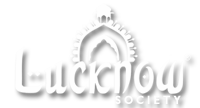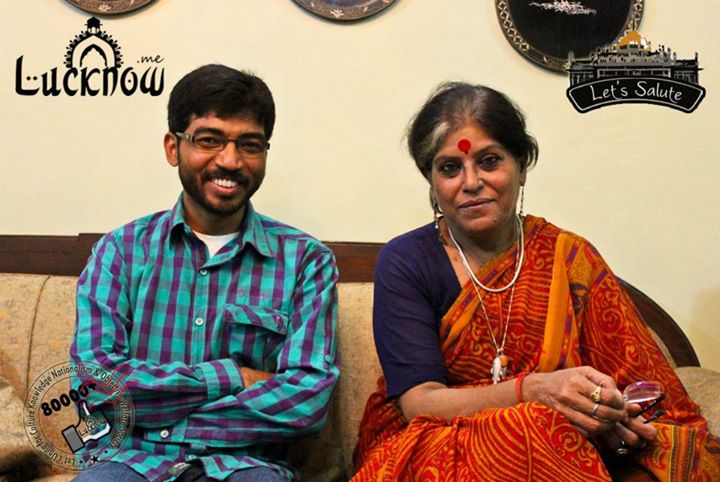At the very first glance, the frail appearance of the Lady betrays the fact that she single handedly brought about a revolution to the socio cultural milieu of the city of Lucknow, involving at least two generations ! Nominated for Nobel Prize in year 2005, Padma Shri Ms Runa Banerjee, trivialises her achievements with a wave of her delicate hand saying there still remains a lot more to do in a lot more ways! The fire still burns her hard work, energy, warmth and endearing smile lights up a thousand ‘hearths and hearts’ of India’s most marginalised – the under-privileged-muslim- woman.
She is gracious and tireless as she introduced us to all her ‘bachchas’ as she refers fondly to the artisans. When we asked her if she ever considered marriage ever, she said, “SEWA ( Self Employed Women’s Association ) is my sweetheart, my child, my world “. It is amazing how Runa Banerjee has sustained this organization despite the social injustice these women still face in this day and age! Impressed with this movement, Mr Muzaffar Ali, another Lucknow personality made a film about SEWA which we all know as Anjuman. Shabana Azmi stayed in Lucknow for months just watching Ms Banerjee work at the centre and Farookh Sheikh till date wears only SEWA Kurta-Pajamas. She has been awarded with several awards & recognition, few of them are Hindustan Times Women Award 2011, TATA Consultancy Services ‘Women Achievers’ Conclave 2011, Women Achiever Award by TCS 2006, Zee Astitwa Award 2008, FICCI Award, FICCI Ladies Organization Award, Yash Bharti Award by UP Government 1994, Special Award by State Women Commission 2005, Indian NGO Award, Distinguished Alumni Award by University of Lucknow, IIM Lucknow Conclave 2007, LMA Oustanding Women Achiever Award 2006, HUDCO Award, PHD Chamber of Commerce & Industry Award 2001, etc.
Born in Model House, Lucknow a predominantly Muslim locality in Lucknow, where hers was probably the only Hindu home, she grew up nestled in the lap of Awadh’s Ganga-Jamuni Tehzeeb, imbibing traits peculiar to Lucknow – respect and love for all religions. In her growing up years however, she could not remain unaffected to the plight of these unfortunate women who lived in penury – who sometimes had to divide ‘one bun between her four children and go without any food herself’. In addition they lived under threat of tuberculosis, malnutrition and alcoholism. A compassionate person, she wanted to bring about a positive change to the lives of these women, still in her twenties, she began by visiting these localities trying to educate the women and children about the benefits of hygiene and cleanliness and experiencing resistance all the while. She shares an interesting and probably a path breaking incident, it was in 1979, that Runa Banerjee organized a health camp in one of the shanty localities in which city’s most prominent, competent doctors, Dr Devika Nag, Dr Mansoor Hasan and others had participated. While the checkups were being carried out and prescriptions written, a woman – she still remembers the name as ‘Qamar Jahaan’ who was intently listening to Dr Hasan, came forward and spoke to Runa ,“ बिटिया जौन कर सको तो हमरे परचा माँ दुपहरिया को चार और साम के बखत चार न होय तो दुइहे रोटी लिखबा देओ”. Dr Hasan stopped in between, shocked by the naked truth of their miserable lives wondering of what use are the medicines and lectures about hygiene when these wretched people did not even have food ! Runa Banerjee was far too disappointed and desolate, analyzing the situation – if all that she had done all these years was worth it ? It was like a clarion call for Runa – there was no looking back and rest is history!
Runa was thence determined to bring a change to their lives and held constant interactions with the community for understanding the need of becoming self-reliant as well as a support for the earning members in the family. The momentum for setting up SEWA, Lucknow came when UNICEF sponsored a study conducted in 1979 itself on the condition of Chikan artisans. The study established that over 40,000 Chikan artisans working in and around Lucknow were highly exploited in the industry and the middlemen reaped all the profits. As a result, Chikan artisans lived in slums and suffered from poverty; they and their offspring were illiterate; and their families had poor health. Following the UNICEF study, Runa and her friend Sebha Hussain started a school for the underprivileged children beginning with only thirty students charging them only one rupee as school fee. The school was such a hit that her students refused to go home. She proudly points out the facing building, the school, the SEWA Montessori School, with classes from nursery to sixth. Then one day a woman Rehana Begum, approached Runa and said , “बिटिया कौनो काम हमरी खातिराऊ कर डारो. And Hence in 1984, began Runa’s mission EARN WHILE YOU LEARN for the women which turned into a profit making organization which we all know as SEWA. She rented a small room at the rate of 75/- per month and the first 31 women began to learn and teach Chikankari. Now they are now over 7500 strong !!! The major agenda for Runa was to do away with the middlemen and the organization to act as a platform from where the artisans would address the market directly.It wasn’t easy though, Runa had no understanding of either business or chikankari for that matter. Also, there was a tremendous opposition from the traders who were watching her work as a stiff competition. Recalls Runa, “when I first went to buy material for embroidery, the cloth merchant at Aminabad gave her – Long Cloth( Latha ) whereas the material generally used is organdie, muslin or cambric! Brick by brick going through various experiences she managed to build SEWA and establish her artisans’ work by sheer hard work and exquisite quality of embroidery. The work as we went through the SEWA complex was the most INTRICATE, DELICATE AND BEAUTIFUL we had ever seen ! She is also one of the founder & active member of ‘Beti Foundation’ which is working for the upliftment of Girls !
She held her first exhibition at the Islamic Cetnre, New Delhi and her first customer was Mrs Sonia Gandhi. Later she liaisoned with the Handloom and Cottage Industry Emporium , New Delhi which fetched her artisans a whopping profit ! And now – they are always hustling – the annual contract from Italy – there exists a SEWA in Milano !!! Annual Chikan exhibits in Dehli and Mumbai. A guardian patron from Norway that led to the property purchase and construction of the lovely building which houses SEWA now.
Runa explained the steps in the making of SEWA Chikan garments. There is the team that buys the fabric, the expert cutters, the teams of expert stampers ( block printing) and the incredible collection of blocks to print with, the artisans who sometimes specialize stitches and work on just one part of the embroidery, the girls who are learning the special skills, the employees who have been with SEWA for as long as even twenty years . Lucknow chikan is perhaps one of the finest forms of embroidery anywhere in the world. The Mughal Queen Noor Jehan revived this style in India. Lucknow enjoys undisputed supremacy in producing India´s finest Chikan embroidery. Due to increasing demands and much required media exposure, the new generation of Lucknow craftsmen are producing newer designs and patterns that have led to its popularity not only in India but also all over the world. Since it is still very much a cottage industry, the patterns are unique and each has its own charm. In addition to the white base fabric, coloured fabrics and threads are also used. Silk and cotton threads are employed for embroidery work on sarees, dupattas, table linen and kurtas. Cotton being the most preferred choice, chikankari is also done on mulls, muslins, voiles, organza and polyester. Some other fabrics include: chiffon, viscose, georgette, polyester georgette, cotton crepe and net. Apart from clothes, one can find chikan embroidery on bed sheets, cushion covers, pillow covers and table cloths. Chikan embroidery combined with crystal work and embellishments can make anyone look and feel royal and elegant. There are 32 types of stitches in Chikankari & some of the popular ones are Tepchi, Bakhiya, Murri, Phanda, Jaali, etc.
Founder LUCKNOW Society has the privilege to meet her & discuss the way forward of the SEWA. LUCKNOW Society Salutes Padma Shri Runa Banerjee for organizing the movement called SEWA and to empower women artisans and self employed women to establish sustainable livelihoods for poverty reduction and rights based sustainable development.To enhance literacy and increase women’s knowledge of law / regulation related to social and gender justice for the achievement of women’s rights. To help the women to access financial and technical resources for improving their shelter, habitat and larger environment. She has revived the traditional art of Lucknow’s Chikankari & promoted it to International level ! Lucknow wishes her all the very best for her next project on old age people !

